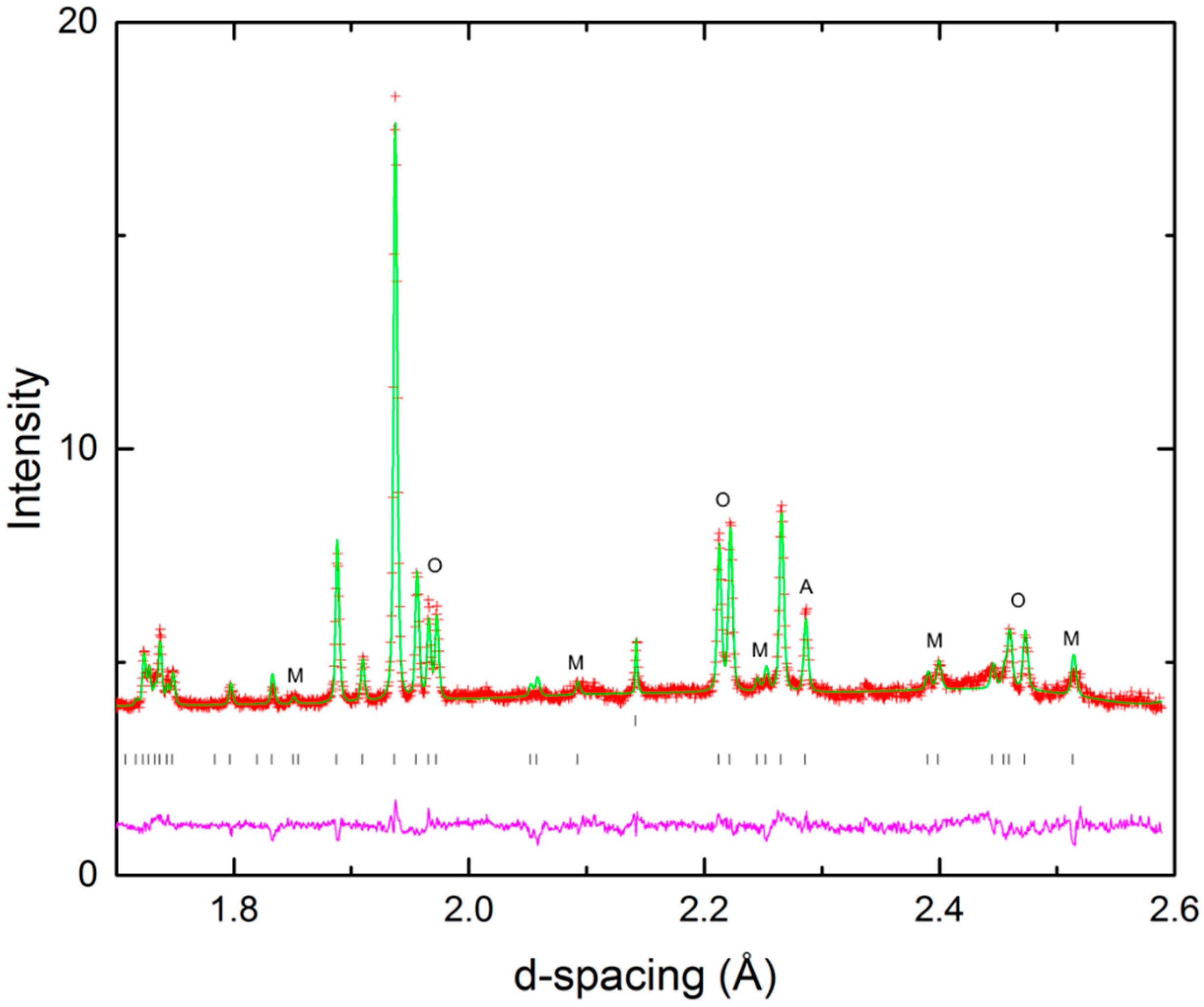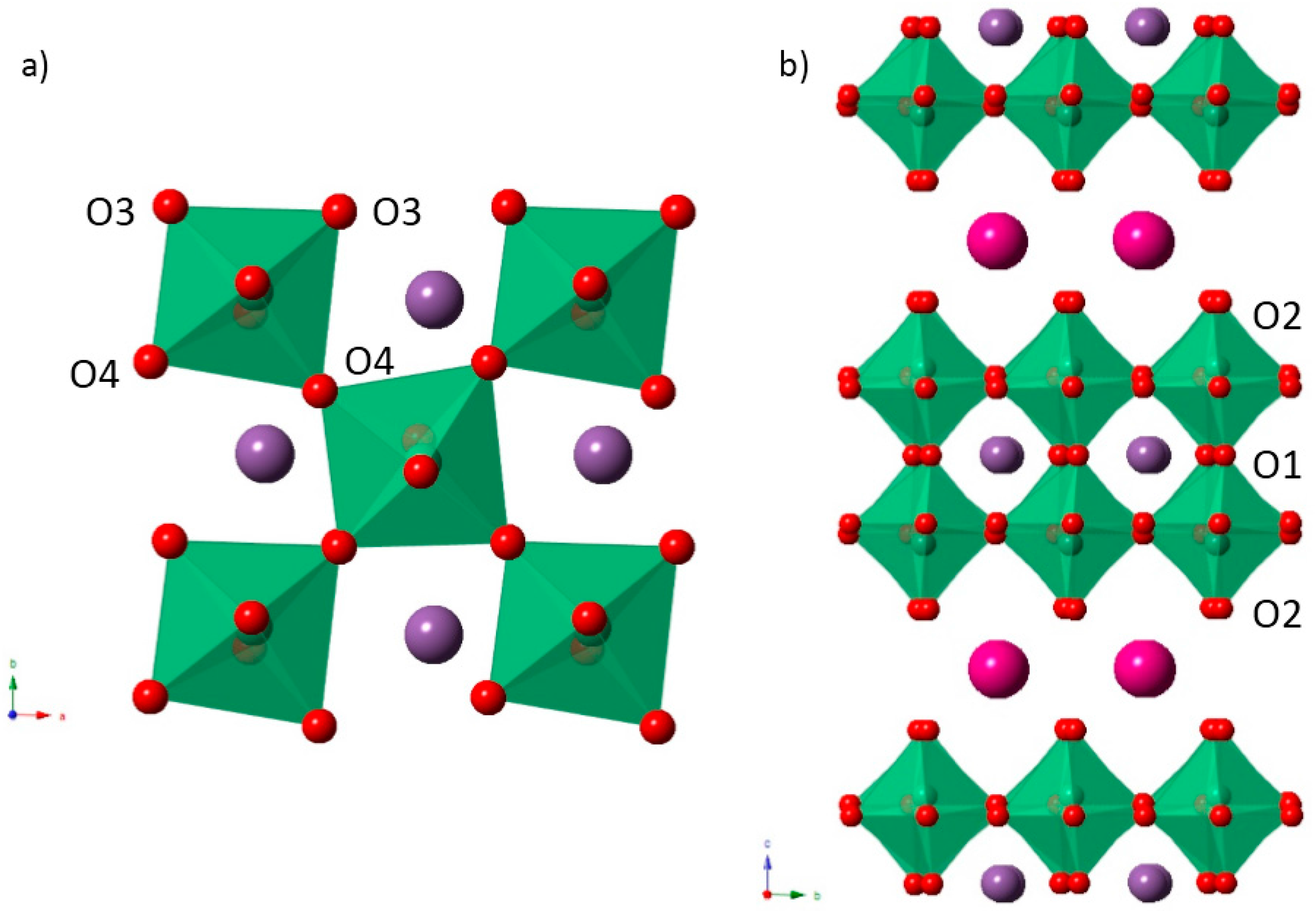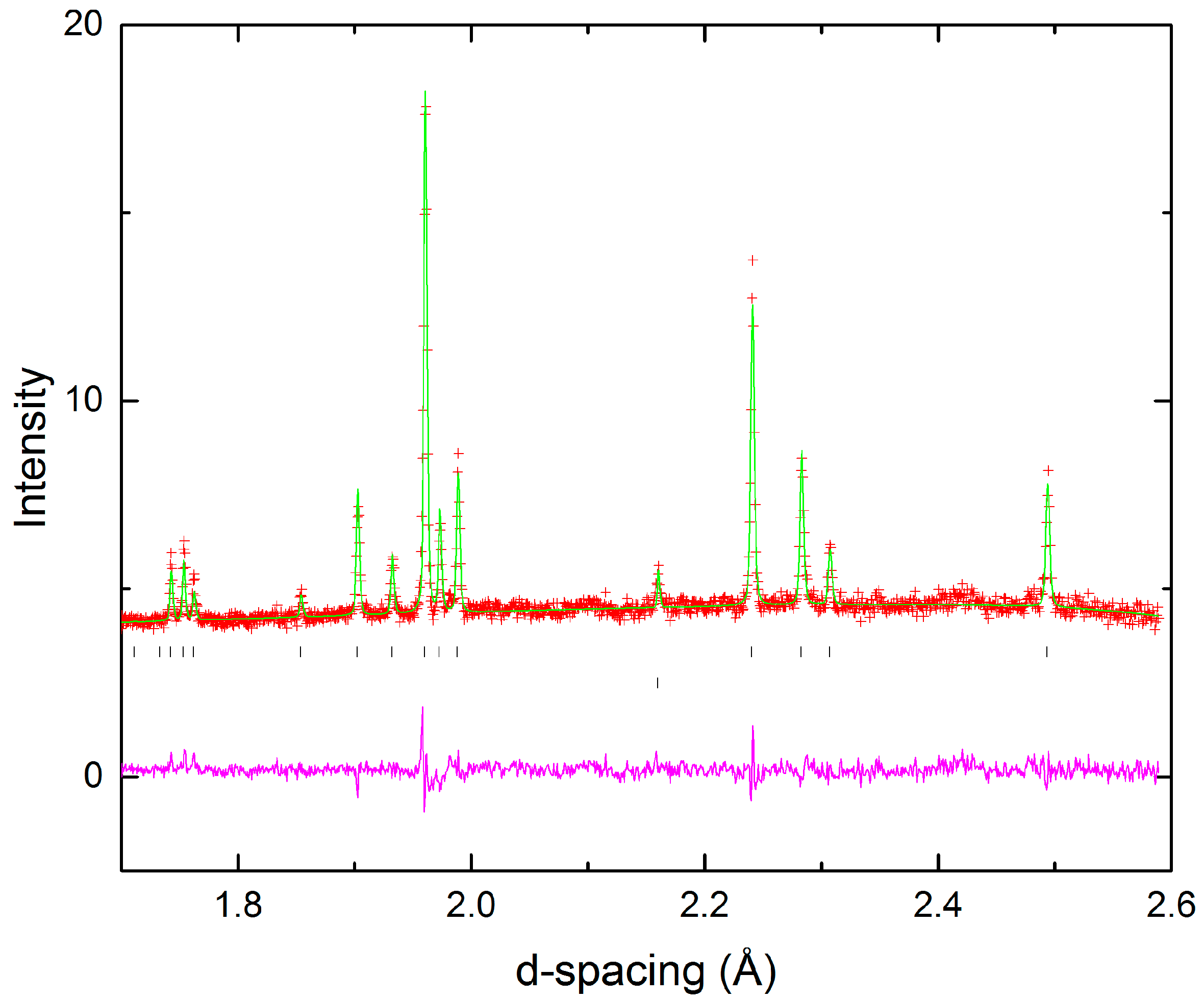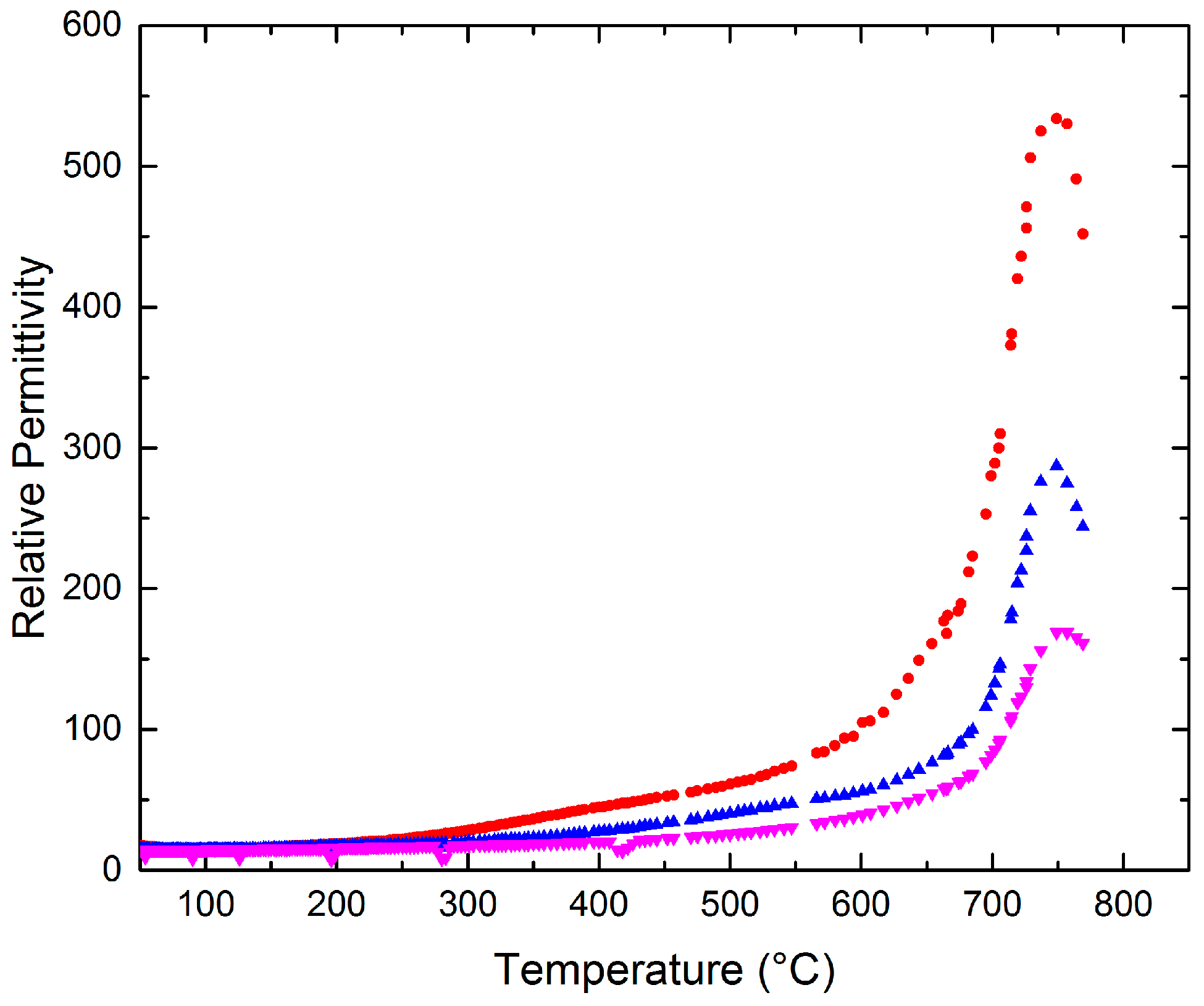1. Introduction
Recent theoretical work has revealed novel mechanisms for designing non-centrosymmetric, polar and potentially ferroelectric materials, based on the coupling of two or more distinct structural distortions (“modes”) [
1,
2,
3,
4]. So-called “hybrid improper ferroelectrics” (HIFs) have now been postulated for several families of layered perovskites, by the coupling of two distinct “octahedral tilt” modes with a polar mode. Although octahedral tilting has been a well-established phenomenon in perovskite crystallography for many years [
5,
6,
7], in simple three-dimensional ABX
3 perovskites all the simple octahedral tilt schemes (as classified by Howard and Stokes [
7]) give rise to strictly centrosymmetric crystals. It is now recognized that in more complex cases, for example cation-ordered or layered perovskites, inversion symmetry may be broken directly by particular combinations of octahedral tilt modes. The concept of HIFs has been typically applied by theorists to mean the imposition of a stable polar ground state in a crystal via the coupling of two or more intrinsically non-polar modes with a polar mode (“tri-linear coupling”), with no requirement for an experimentally-realized polarization reversal. However, such experimental demonstrations of polarization-field hysteresis have now been reported, for example in the Ruddlesden-Popper (RP) phase Ca
3Ti
2O
7 [
8] and the Dion-Jacobson (DJ) phase RbBiNb
2O
7 [
9].
Prior to the recent flurry of work from the theoretical standpoint, it was known that ferroelectricity, or at least polarity, co-existed with octahedral tilting in several layered perovskites, the most well-established being the Aurivillius family, exemplified by SrBi
2Ta
2O
9 and Bi
4Ti
3O
12 [
10]. Snedden et al. [
11] later made the intuitive link between the nature of octahedral tilting in the DJ phase CsBiNb
2O
7 and that in SrBi
2Ta
2O
9; both have a tilt system analogous to that described by the Glazer notation a
−a
−c
+ in ABX
3 perovskites. This leads to related superlattices and space groups in both SrBi
2Ta
2O
9 and CsBiNb
2O
7, viz. superlattices of ~√2
at x √2
at x
ct relative to the aristotype tetragonal phase in each case, and polar space groups
A2
1am and
P2
1am in SrBi
2Ta
2O
9 and CsBiNb
2O
7, respectively. The nature of these superlattices and the allowed space groups of the possible distorted structures may be systematized by considering which particular distortion modes give rise to the specific tilts within each family of layered perovskites. So, for example, the “out-of-phase tilt”, a
−a
−c
0, and the “in-phase tilt”, a
0a
0c
+, correspond to the modes with irreducible representations M
5− and M
2+, respectively, for the DJ phases of the type AA’B
2O
7, for which the parent phase is described in space group
P4/
mmm (these are “
n = 2” examples of the generic DJ composition AA’
n−1B
nO
3n+1, with
n representing the number of octahedral layers per perovskite-like block). The coupling of the two modes leads naturally to the polar space group
P2
1am for CsBiNb
2O
7 and, in principle, permits ferroelectricity. These ideas have been described in more detail by Benedek et al. [
3,
4].
Although the a
−a
−c
+ tilt system is predicted to be a stable option for DJ phases of the type AA’B
2O
7, recent experimental work has shown that other related polymorphs are possible, and a tilt system a
−b
0c
+, in polar space group
Amm2, has been reported in CsLaNb
2O
7 in the range 350 < T < 550 K [
12] (curiously an earlier single crystal X-ray study of CsLaNb
2O
7 reported the adoption of the aristotype tetragonal structure,
P4/
mmm at 296 K [
13]). Moreover, a recent experimental and theoretical study of the triple-layer DJ phase CsBi
2Ti
2NbO
10 has suggested that a proper rather than improper mechanism drives the polarity of the ambient temperature phase [
14]. It is therefore of interest to explore more fully the phase behavior of further examples of the DJ family in order to map out the occurrence of the possible tilt systems, especially those giving rise to polarity, and also the nature of phase transitions in these systems as a function of
T.
In our earlier work [
11], it was established that both CsBiNb
2O
7 and CsNdNb
2O
7 adopted the polar
P2
1am space group at ambient temperature, with the latter composition displaying a much reduced orthorhombic distortion relative to the former. Later, Fennie and Rabe predicted ferroelectricity in CsBiNb
2O
7 from a first-principles DFT study [
15]. Our follow-up experimental studies [
16] on CsBiNb
2O
7 suggested that ferroelectricity was hindered by moisture uptake, leading to proton conductivity and leakage. Nevertheless, a more recent work by Chen et al. [
17] did provide experimental evidence for ferroelectricity in this compound. Goff et al. [
16], attempted to determine any high temperature phase transitions in CsBiNb
2O
7 using powder neutron diffraction: no evidence for phase transitions was identified up to 900 °C, above which sample deterioration precluded further study. By analogy with CsNdNb
2O
7, we speculated that La-doping of CsBiNb
2O
7 would reduce the orthorhombic distortion such that any phase transition to higher symmetry might be brought down in temperature relative to that of CsBiNb
2O
7, and make this transition more amenable to experimental study.
In this paper, we report the phase behavior of CsBi0.6La0.4Nb2O7; this composition was chosen since CsBiNb2O7 and CsLaNb2O7 have been shown to adopt different phases at ambient temperature, and it was anticipated that a phase transition(s) might be observable within a reasonable temperature regime.
2. Results
Ambient temperature structure: Preliminary studies focused on the solid solution CsBi
1−xLa
xNb
2O
7 (see
Supplementary Information), which is confirmed to exist for all compositions, 0 <
x < 1. The
x = 0.4 composition, i.e., CsBi
0.6La
0.4Nb
2O
7, was chosen for further study by high-resolution powder neutron diffraction. Initial analysis of the room-temperature powder neutron diffraction (PND) data assumed the
P2
1am model previously identified for CsBiNb
2O
7 [
11]. Rietveld refinement suggested this model to be correct, with an excellent fit, accounting for all observed peak splittings and superlattice peaks (
Figure 1). However, in order for this assignment to be unambiguous, other options need to be considered. There are two aspects to this: first, the unit cell metrics need to be determined and second, the nature of any characteristic superlattice peaks (especially those arising from octahedral tilting) needs to be established.
Considering the unit cell metrics first: the possible superlattice options to be considered are either an approximate doubling or quadrupling of the unit cell in the
ab plane; i.e.,
a ~
b ~ √2
at or
a ~
b ~ 2
at. Superlattices along the
c-axis are not considered in the simplest scheme (and are not necessary in this case). These two options can easily be distinguished based on related peak splittings observed in the experimental PND data: the √2
at metric splits peaks of the type (
hhl) in the parent tetragonal phase, whereas the 2
at metric splits peaks of the type (
h0l/
0kl). Specific peaks labelled in
Figure 1 confirm unambiguously that an orthorhombic (or lower) symmetry unit cell of metrics
a ~
b ~ √2
at,
c ~
ct, is required to account for all the observed peak splittings.
Strayer et al. [
12] listed all models corresponding to the simple combinations of octahedral tilts for this structural family (see Supplementary information in Reference [
12]). Specifically, the definition of simple combinations here means that there are four distinct octahedral tilts modes to be considered, viz. in-phase and out-of-phase tilts of two adjacent octahedra along the
a (and/or
b) and
c axes of the parent tetragonal unit cell. These four modes are given the Glazer-like symbols a
+ (or b
+) and c
+ for the respective in-phase tilts and a
− (b
−) and c
− for the out-of-phase tilts. In turn, these distortions give rise to superlattice peaks in the diffraction pattern at characteristic points, labelled
M (
k = ½, ½, 0) or
X (
k = 0, ½, 0) relative to the parent tetragonal reciprocal lattice. The specific modes corresponding to each of the four possible tilts are X
1+ (a
+), M
5− (a
−) M
2+ (c
+) and M
4− (c
−). The nature of these modes and their effect on the diffraction pattern can be probed using the on-line software ISODISTORT [
18]. The
X-point mode can be easily ruled out (no peaks are visible at the relevant positions), but the
M-point modes provide some ambiguity, as they may contribute to many of the same superlattice peaks. In fact, closer inspection of the allowed superlattice intensities from each of the
M-point modes reveals that the M
4− mode can also be ruled out: we also note that neither the X
1+ nor the M
4− modes were considered in the earlier theoretical studies [
3,
15]. The M
5− mode is certainly required, as it is the only contributor to certain peaks (for example the one near
d ~ 2.5 Å). The M
2+ mode contributes to several observed peaks (for example those near
d ~ 2.4 Å), but the M
5− mode may also contribute to those.
Table 1 lists an abbreviated selection of the possible octahedral-rotation-induced superlattices of Strayer et al. Taking into account the requirement of a √2
at x √2
at x
ct orthorhombic metric and the presence of at least the M
5− mode (and also possibly the M
2+ mode) reveals the only plausible models are the
P2
1am and
Pmam ones, as suggested by Snedden et al. [
11] for CsBiNb
2O
7. In particular, the
Amm2 model observed for CsLaNb
2O
7 can be ruled out in the present case. In order to confirm
P2
1am as the correct model for CsBi
0.6La
0.4Nb
2O
7 at ambient temperature, a comparative refinement against the
Pmam model was carried out. This led to agreement factors of χ
2 ~ 5.870 and 9.081, for the
P2
1am and
Pmam models.
P2
1am is therefore selected as the best model at ambient
T. The corresponding crystal structure is shown in
Figure 2, refined atomic parameters are given in
Table 2 and selected bond lengths in
Table 3.
Structural Evolution Versus
T: The continued presence of orthorhombic distortion can easily be determined on raising the temperature, by tracking the O peak splittings highlighted in
Figure 1. However, since the
M-point superlattice peaks are very weak, even at ambient temperature, it is problematic to use a simple qualitative visual observation of these as a single reliable measure of the structural distortions versus
T. Instead, full comparative Rietveld refinement of the structure in both
P2
1am and
Pmam models is the preferred method of discrimination (since the tilts significantly affect the intensities of the subcell peaks, in addition to the supercell peaks). Both models were therefore refined against each data set up to 725 °C, taking care to use a consistent set of parameters throughout (see Experimental). At 700 °C the orthorhombic splitting is still clearly seen in the raw data, but at 725 °C the splitting disappears, and the unit cell becomes metrically tetragonal (
Figure 3). The parent
P4/
mmm model was therefore trialed at 725 °C and above, with a further check on the alternative possible tetragonal model,
P4/
mbm (a
0a
0c
+,
Table 1) at 725 °C only. In addition to tracking the comparative fit quality for the two orthorhombic models, ISODISTORT was used to derive the mode amplitudes versus
T. Thermal evolution of the unit cell parameters is given in
Figure 4, and for the distortion modes in
Figure 5. Comparative goodness-of-fit parameters (χ
2) for the
P2
1am and
Pmam models are given in
Figure 6.
The difference in χ
2 values clearly supports the assignment of the
P2
1am rather than the
Pmam model up to 700 °C (χ
2 values are 2.055 and 2.273 for
P2
1am and
Pmam, respectively, at 700 °C). In addition, the tilt mode amplitudes (
Figure 5) tend towards zero, but do not become zero, at 700 °C. The negligible difference in fit quality between the four models tested at 725 °C (χ
2 values 2.065, 2.054, 2.041 and 1.883 for
P4/
mmm,
P4/
mbm,
Pmam and P2
1am, respectively) supports the absence of both tilt modes at this temperature (we note that the refinement in the P2
1am model was unstable to the refinement of thermal parameters, thus a direct comparison is not possible). Although the unit cell volume has no clear discontinuity within the temperature resolution of our datasets, the fact that the polar mode Γ
5− seems to have a step-like change at the transition may indicate the existence of a first-order component.
We attempted to fit the thermal evolution of the tilt modes, M
2+ and M
5−, to critical behavior of the form: amplitude = A (T
c − T)
β. This produced the fit parameters of A = 0.0292, 0.227; T
C = 749, 742 °C; β = 0.401, 0.127 for the M
2+ and M
5− modes, respectively. The key observation here is that the derived value of T
C is approximately equal for the two modes, implying that they condense simultaneously. Unfortunately, the paucity of data in the vicinity of T
C prohibits a definitive conclusion about the exact T
C and β values, and also the specific mode which drives the transition. However, further support for our crystallographic model comes from a measurement of dielectric properties versus
T.
Figure 7 shows a single dielectric maximum just below 750 °C, with no evidence of any lower temperature anomalies. This supports an abrupt, single phase transition, as was observed crystallographically.
Taken together, these observations suggest a direct to transition from
P2
1am to
P4/
mmm in the vicinity of 700–750 °C; we note that Landau theory requires the direct
P2
1am to
P4/
mmm transition to be first-order, whereas the
Pmam to
P4/
mmm transition is allowed to be continuous. Hence, the most likely scenario, which is also compatible with the present data, is that both tilt modes are lost simultaneously, with no substantial evidence for an intermediate phase of symmetry
Pmam or
P4/
mbm (
Table 1). The final refined model in
P4/
mmm at 750 °C is given in
Table 4 and
Table 5.
3. Discussion and Conclusions
The present study indicates, within the temperature resolution of our data, a direct first-order transition from the parent, untilted phase,
P4/
mmm, to the observed ambient temperature phase,
P2
1am (tilt system a
−a
−c
+). This requires the simultaneous condensation of the two tilt modes M
5− (a
−a
−c
0) and M
2+ (a
0a
0c
+), which couple with the polar mode, Γ
5−. This special case of tri-linear coupling has been termed an “avalanche transition” [
19]. Due to the temperature increments used in this experiment, we cannot fully rule out a possible intermediate phase of symmetry
Pmam or
P4/
mbm but, if present, this must only exist in a narrow temperature interval around 700 to 750 °C. Avalanche transitions are rare, but such a transition has been confirmed in the Aurivillius phase ferroelectric, SrBi
2Nb
2O
9 [
20,
21], which also displays the tilt system a
−a
−c
+. It has been suggested that SrBi
2Nb
2O
9 differs from its analogue SrBi
2Ta
2O
9, which does display an intermediate phase (tilt system a
−a
−c
0), because the magnitudes of the three necessary distortion modes in the ground state (i.e., ambient temperature) polar phase are relatively similar, rather than one tilt mode being dominant [
21]. In their detailed study of CsLaNb
2O
7, Strayer et al. [
12], reported a tilt system a
−b
0c
+ (space group
Amm2,
Table 1) between 550 and 350 K. This phase also requires the condensation of both the M
2+ and M
5− tilt modes, but differs from the present
P2
1am phase in the direction of the M
5− mode. It might also be expected that an intermediate phase would be observed in the
P4/
mmm to
Amm2 pathway seen in CsLaNb
2O
7; i.e., via the sequential loss of either M
5− then M
2+, or vice versa. The corresponding intermediate phases (
Table 1) in that case would be a
0a
0c
+ (
P4/
mbm) or a
−b
0c
0 (
Cmmm). Strayer et al. ruled out these pathways by the observation of a clear SHG signal, signifying non-centrosymmetricity, and thus implying an avalanche transition in this composition also. As the present study represents the only detailed crystallographic study so far of the tilt transitions concerning a verified
P2
1am phase (a
−a
−c
+) in the
n = 2 DJ family, it remains to be seen whether such avalanche transitions are common in the DJ family.













